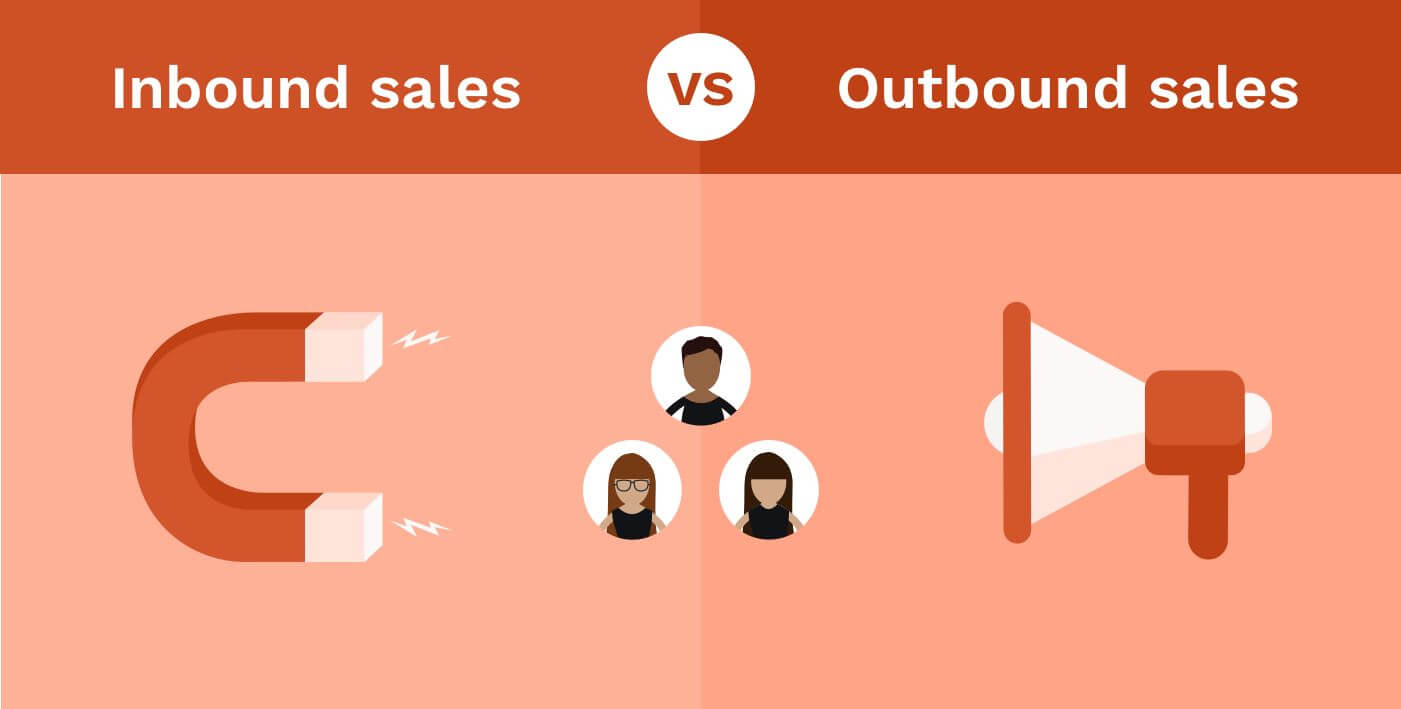The definition of outbound sales
The definition of outbound sales
Outbound sales is the process of your sales team reaching out to leads, and it’s an important part of any business. This is typically done through cold calling, cold email outreach, social media, and a few other forms. With outbound sales, you get to choose which prospects you want to target and how you want to make contact with them.
All too often businesses struggle with their outbound sales process.
What is the difference between inbound and outbound sales?

When it comes to generating sales, you essentially have two major options – you can either reach out to leads, or you can draw the leads into you. Outbound sales is when you take the initiative, while inbound sales is when your prospects come to you. Each has their own advantages, and both are vital for business growth.
Let’s look at two examples. In an outbound approach, you might have a Sales Development Representative (SDR) scan through a lead database to find potential customers. Once they find someone that fits your ideal customer profile, they would then make contact with the lead to gauge their interest. If they seem interested, the SDR would then hand off the lead to one of your sales reps.
With an inbound sales approach, you would do something like start a blog. You’d hire some writers to create content on your blog based on what your ideal customers are likely to search for online. Then, through other marketing strategies, your target customers would find these blog posts, hear about your business, and inquire for more information.
Successful businesses will not only make use of both approaches, but they will look for ways to optimize each strategy. To get better at the outbound side of sales, here are 6 tips you can use.
6 ways to get better at outbound sales
#1 – Target the Right Leads
As we said above, one of the advantages of outbound sales is that it allows you to more accurately target your ideal customers. With inbound sales, you can tailor your content marketing strategy to fit a certain niche, but that doesn’t mean they’ll necessarily come in. Outbound sales, on the other hand, lets you pick the exact type of customer you want to target, then reach out to them.
However, this doesn’t help you much if you’re targeting the wrong people. So to get better at outbound sales, you need to target the right leads. Really take the time to develop a comprehensive customer profile by asking yourself questions such as:
- How large is the company?
- How much revenue do they generate?
- What role does your target have within their company?
- How long has the business been operating?
- What sort of technology are they using?
- What are the biggest issues facing that company or that niche?
The more complete you can make your ideal customer profile, the better your targeting will be. Doing this will ensure that your sales team is only spending their time on the best possible leads.
#2 – Surround Yourself with The Right Team
Sales is a team effort. You need the best people on your team operating efficiently if you want your business to grow. Unfortunately, too many businesses are using a sales staff that is less than ideal. It’s important that you regularly assess your own sales staff and determine if they are the right people for the job.
What does the best sales team look like? For starters, they are all ambitious people who want to see your company grow. They get excited by the idea of making sales and are always looking for ways to improve their skills. Depending on how your sales team is set up, you may want some people who are great on the phone, others who can write really great emails, and others who are good at prospecting and qualifying leads. In some cases, you’ll want individuals who can do all three.
As your sales team works, keep track of their progress. How many sales are they making each month? How many phone calls do they make a day? What’s their rejection rate? By keeping some hard numbers on each of your sales team members you can compare them against one another, then either help the underperforming team members improve, or cut them loose.
#3 – Know Your Value, Then Promote It
An essential part of any sales pitch is knowing your own value. Why would a potential customer choose you over a competitor? Or if you don’t have a direct competitor, why would that customer choose you at all? Too many businesses try to please everyone or fit every possible need of a company. This approach ends up making your business sound generic. Instead, you need to think about the specific value you’re bringing to the table and why your leads need to do business with you rather than someone else.
Once you’ve thought about this, distill it down into a few main points. Then you want to take every opportunity you can to promote these key points. Mention them in your newsletter. Bring them up during phone conversations. Talk about them when you’re networking at events. When potential customers talk to a member of your sales team, they should walk away knowing exactly what it is you provide and why you’re their best option.
#4 – Use Multiple Lead Sources
There are many ways that a business can go about acquiring leads. If you find that you’re struggling with your outbound sales, the problem could be that you’re not getting your leads from enough different sources.
For example, some businesses will rely heavily on a lead database. These are great at delivering contact information for dozens, hundreds, or even thousands of potential clients. But they aren’t the only option. While using a lead database you could also be using LinkedIn Navigator, Twitter, Facebook, local business directories, and more. There’s going to be some overlap between these various sources, but there’s also going to be plenty of new targets. If your business is currently only using 1 or 2 lead sources, try expanding to a few more and see if it helps fill up your sales pipeline.
#5 – Improve Your Handoff
A key component of the outbound sales process is the handoff between your SDRs and your Account Executives. Your SDRs can’t simply set up a meeting and then notify the salesperson where and when to show up. When trying to improve their outbound sales processes, many businesses will focus on either the SDR or the salesperson and forget about the in-between area.
To improve this handoff, there are a few things you can try. First, make sure your SDR is getting as much relevant information as possible. The more they can learn about the prospect before handing it off, the more prepared the salesperson will be when the meeting arrives.
Next, have a good system in place for scheduling meetings and sending out reminders. When an SDR schedules a meeting with a prospect, both the prospect and the salesperson should get an alert, and a reminder as the day approaches. You should also ask for your prospects to confirm the meeting shortly beforehand. You don’t want your salesperson to waste their time by showing up to a meeting in which the prospect doesn’t show. And even if you’re not scheduling face-to-face meetings, you can use the same principles when setting up sales calls.
Getting a prospect to agree to meet with your salesperson is often the hardest part of the sales process. At this point you’re so close to a sale that it would be a waste if you were to make a mistake here. Spend some time analyzing how your SDRs pass along prospects to your sales team, then look for ways to improve.
#6 – Integrate the Best Technology
Finally, the right technology makes a big difference when you want to improve your outbound sales process. In today’s modern world it’s hard to operate at a fast pace if the technology you’re using can’t keep up or isn’t providing all the features you need.
For outbound sales, a few tools are necessary. The most important one a sales CRM. With a good CRM you can manage all the information about your prospects and current customers, all in one place. You can see how far along your sales process a certain prospect is, track information that’s pertinent to your sales (such as the size of their company or a person’s role within a business), and in some cases send out messages directly from the CRM. It’s an essential tool that every business that deals with outbound sales needs to have.
Besides that, there are a few other tools you’ll want to look into. A lead database makes it easy to find new leads for your business, a sales intelligence tool to help you learn more about your leads, a communication tool like Slack so you can quickly interact with other team members, and some social media tools to make managing your accounts easier.
With the right tech stack, you can improve SDR productivity, communication within your business, make time-consuming tasks faster, and learn more about your prospects. Think about which areas your business is having the hardest time with, then look for some tools that can help you solve your problem.
Wrapping up
If your outbound sales is not bringing you the type of results you’d like, you don’t have to accept this. There are always ways to improve, you just need to first figure out where you’re going wrong. And if you’d like some help with your outbound sales process, book a free consultation with TaskDrive today.



